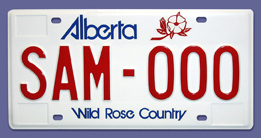Lesson 1
1. Lesson 1
1.4. Explore 3
Module 3: Permutations, Combinations, and the Fundamental Counting Principle

Courtesy of Alberta Motor Vehicles. Reproduced with permission
The fundamental counting principle can also be applied in situations where there are some restrictions on the choices. For example, if you want to determine the number of possible phone numbers, you need to know that you cannot use a zero as the first digit.
For many questions, there is a much more efficient way of calculating outcomes than drawing a tree diagram or creating an outcome table. Sometimes it is easier to represent a problem by drawing blanks for the outcomes. For example, how many licence plates can be made with three letters (L) followed by three digits (D)?
|
Draw blanks to represent the three letters (L) and the three digits (D) in a licence plate. |
|
There are 26 letters in the alphabet, so each of the first three blanks can be filled in 26 ways (A to Z), assuming you are allowed to repeat letters. |
|
Each of the digit blanks can be filled in 10 ways (0 to 9). |
26 × 26 × 26 × 10 × 10 × 10 = 17 576 000 |
Therefore, according to the fundamental counting principle, all of the blanks can be filled in 26 × 26 × 26 × 10 × 10 × 10 or 17 576 000 ways. |
In the next Try This, you will use blanks to help solve a problem.
Try This 3
A group of 10 children is lined up to go outside for recess. How many different ways can the children line up?
Draw 10 blanks to represent the 10 places in line.
_ _ _ _ _ _ _ _ _ _
- How many possible children could be placed in the first spot in line?
- Now that one child has been placed first in line, how many children are left that could be placed in the second spot?
- Finish determining the number of possibilities for each place in line.
- Use the fundamental counting principle to calculate the total number of ways the children can be lined up.

![]() Save your responses in your course folder.
Save your responses in your course folder.
Self-Check 2
- Consider the question about licence plates posed in the Focus section at the start of this lesson. In 2010, Ontario switched from three digits and three letters to four letters and three digits. With a partner or in a group, determine how many more licence plates are available in Ontario now with the fourth letter added. Answer
![]()
- Complete “Your Turn” on the bottom of page 69 of your textbook. Which lock has more restrictions—A or B? Explain. Answer